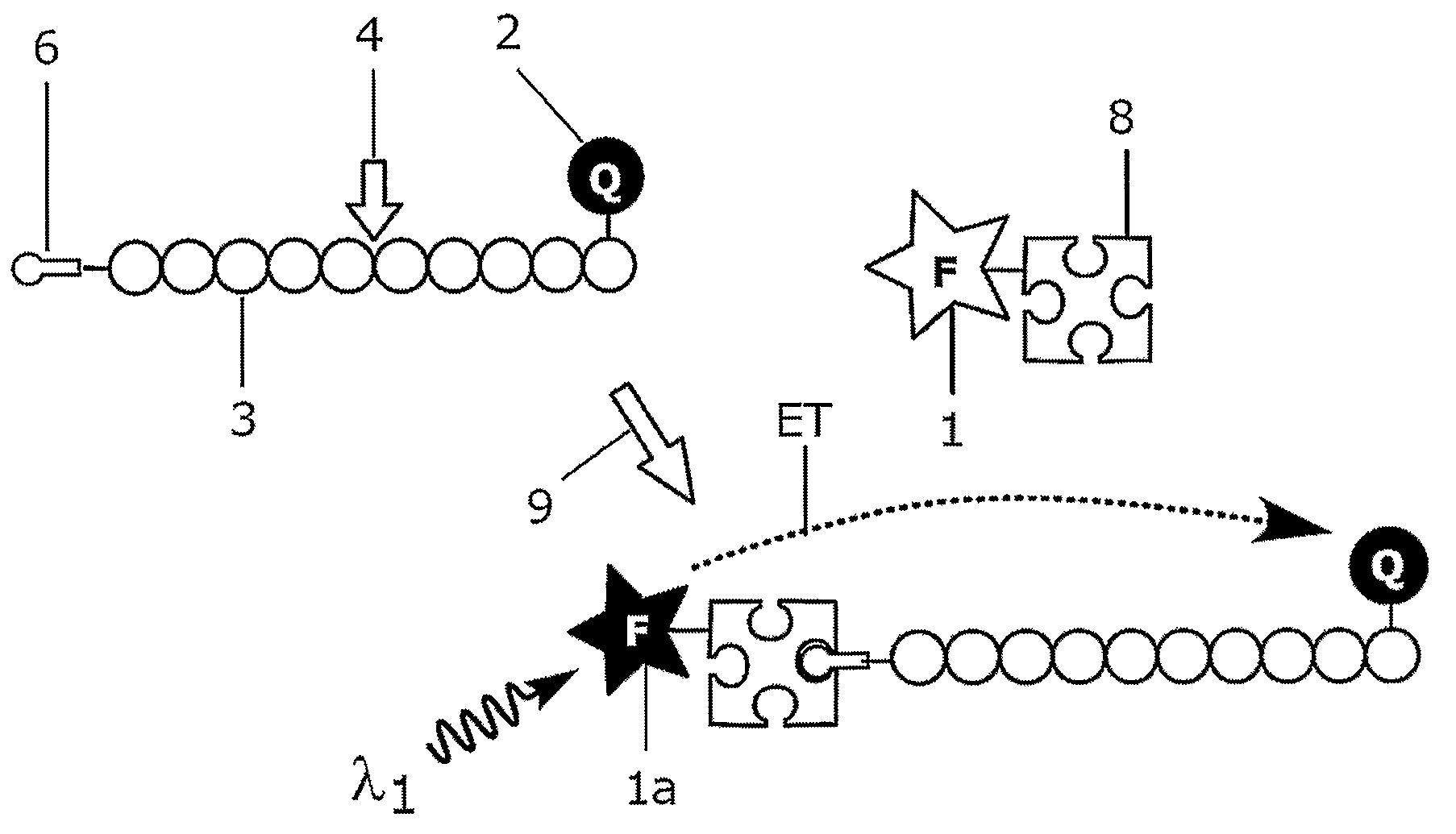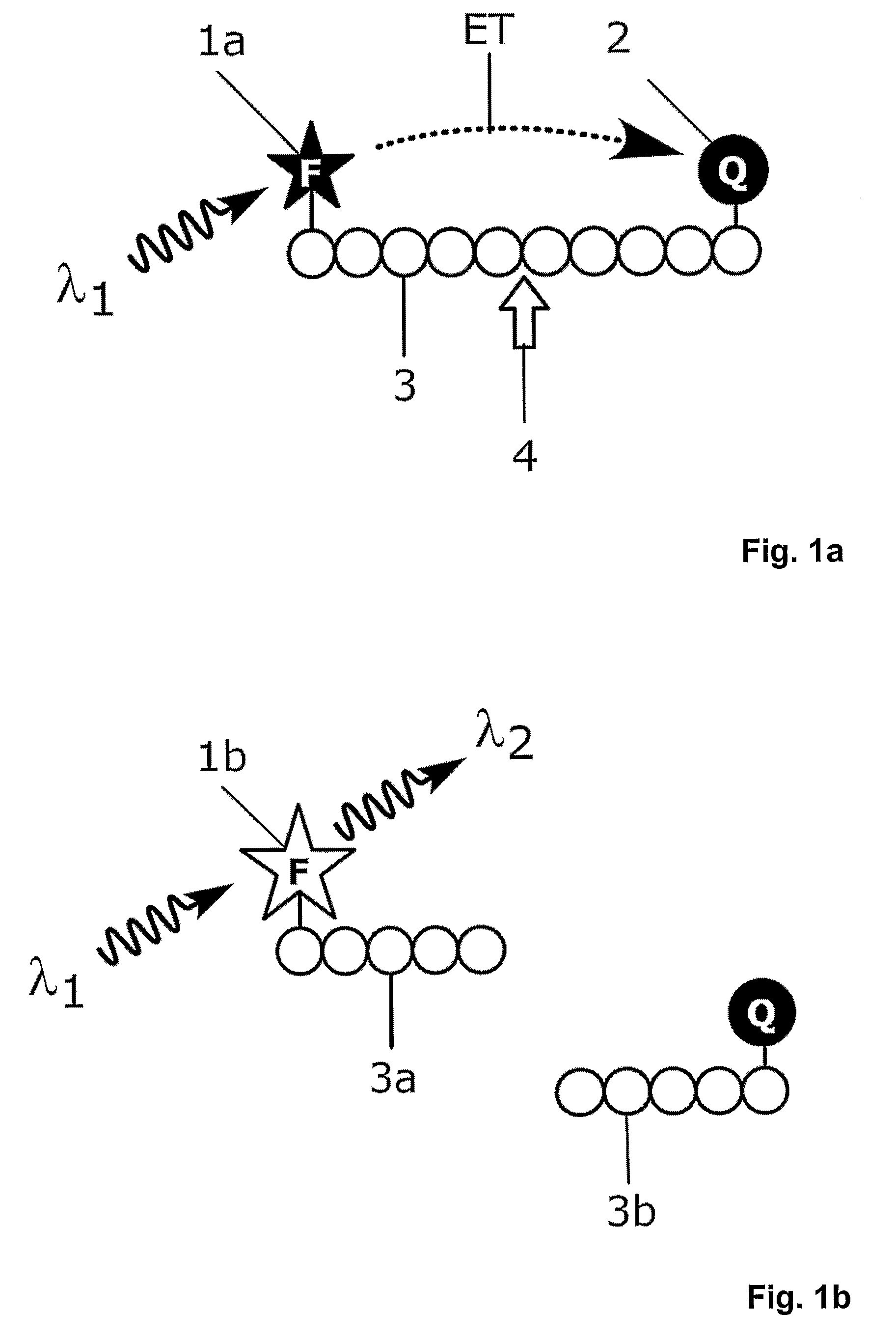Homogeneous Luminescence Bioassay
a luminescence bioassay and homogeneous technology, applied in biochemistry apparatus and processes, instruments, sugar derivatives, etc., can solve the problems of limited further improvement of sensitivity, significant increase of background signal, and serious limitations of sensitivity
- Summary
- Abstract
- Description
- Claims
- Application Information
AI Technical Summary
Problems solved by technology
Method used
Image
Examples
example 1
[0140]A minoreactive CyDye Fluor Cy 5 obtained from Amersham Biosciences (Uppsala, Sweden) was conjugated to an aminoderivative of biotin (2-(((N-(biotinoyl)amino)hexanoyl)amino)ethylamine; Molecular Probes, Leiden, Netherlands) to produce a biotinylated conjugate of Cy 5 dye. The conjugation reaction contained 0.1 mg of Cy 5 dissolved in 50 mmol / l carbonate buffer, pH 9.3 with 20% (v / v) dry DMF and a 20-fold molar excess of aminoderivative biotin in total volume of 100 μl. The reaction was incubated at +35° C. for 3 h and purified with HPLC using a C18-RP-column (JonesChromatography, Mid Glamorgan, UK). The biotinylated conjugate of the Cy 5 dye was diluted in water to concentrations of 0.1 nmol / l to 500 nmol / l. Fluorescence of the dye was measured from a 200 μl volume of each dilution and blank from clear 96-well microtitration plate wells using fluorescence mode of Wallac Victor multilabel counter with an excitation filter at 615 nm and emission filter at 665 nm. The results are ...
example 2
[0141]Synthetic oligonucleotide substrate 5′-TC TGA GGG TGA ACT TGC G-3′, labelled from 5′ end with a dual function building block containing both biotin and Cy 5 and from 3′ end with BHQ-2, was obtained from Thermo Electron Corporation.
[0142]The complete sequence of the oligonucleotide substrate is[0143]biotin-Cy 5-5′ TC TGA GGG TGA ACT TGC G 3′-BHQ-2
wherein[0144]Cy 5=CyDye Fluor Cy 5 from Amersham Biosciences[0145]BHQ-2=Black Hole Quencher 2 from Biosearch Technologies
and its molecular weight is 7071.1 g / mol.
[0146]Europium(III)-chelate dyed Fluoromax nanoparticles 92 nm in diameter, obtained from Seradyn Inc (Indianapolis, Ind.), were coated with streptavidin according to Härmä, H., et al. Europium nanoparticles and time-resolved fluorescence for ultrasensitive detection of prostate-specific antigen in Clin Chem 2001; 47: 561-568. Nanoparticles were prewashed with 10 mmol / l phosphate buffer, pH 7.0, on a Nanosep microporous centrifugal filter (300 kDa cutoff; Pall Filtron, Northbo...
example 3
[0149]Streptavidin was labelled with fluorescent europium chelate labelling reagent {2,2′,2″,2′″-{[2-(4-isothiocyanatophenyl)ethylimino]bis(methylene)bis{4-{[4-(α-galactopyranoxy)phenyl]ethynyl}pyridine-6,2-diyl}bis(methylenenitrilo)}tetrakis(acetato)}europium(III) (von Lode P, Rosenberg J, Pettersson K, and Takalo H. A europium chelate for quantitative point-of-care immunoassays using direct surface measurement; Anal Chem 2003; 75: 3193-201). The labelling of streptavidin performed in 50 mmol / l sodium carbonate buffer, pH 9.8, using 50-fold molar excesses of the chelate labelling reagent. The reaction was carried out overnight at room temperature and the excess free labelling reagent removed on NAP-5 and NAP-10 (Amersham Biosciences) chromatography columns using Tris-saline-azide (6.1 g / l Tris, 9.0 g / l NaCl, and 0.5 g / l NaN3), pH 7.75, as elution buffer. The fractions containing the streptavidin was collected and the europium concentrations were measured against a europium calibrat...
PUM
| Property | Measurement | Unit |
|---|---|---|
| diameter | aaaaa | aaaaa |
| diameter | aaaaa | aaaaa |
| diameter | aaaaa | aaaaa |
Abstract
Description
Claims
Application Information
 Login to View More
Login to View More - R&D
- Intellectual Property
- Life Sciences
- Materials
- Tech Scout
- Unparalleled Data Quality
- Higher Quality Content
- 60% Fewer Hallucinations
Browse by: Latest US Patents, China's latest patents, Technical Efficacy Thesaurus, Application Domain, Technology Topic, Popular Technical Reports.
© 2025 PatSnap. All rights reserved.Legal|Privacy policy|Modern Slavery Act Transparency Statement|Sitemap|About US| Contact US: help@patsnap.com



